Engine valve clearance check (Every 12 000 miles (20 000 km) or 12 months)
SOHC engines
1 The valve clearances must be checked with
the engine cold. On carburettor models
remove the air cleaner.
2 Disconnect the HT leads from the spark plugs and release them from the clips on the camshaft cover.
3 On fuel injection models, unbolt and remove the bracing strut securing the inlet manifold to the right-hand side of the cylinder head.
4 Where applicable, unclip any hoses and wires from the camshaft cover, then unscrew the securing bolts and remove the camshaft cover and gaskets. Take care not to lose the spacer plates which fit under the bolt heads, where applicable.
5 Numbering from the front (camshaft sprocket) end of the engine, the exhaust valves are 1, 3, 5 and 7, and the inlet valves are 2, 4, 6 and 8.
6 Turn the engine clockwise using a suitable socket on the crankshaft pulley bolt, until the exhaust valve of No 1 cylinder (valve No 1) is fully closed; ie the cam lobe is pointing vertically upwards (see illustration).
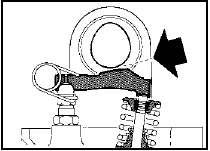
23.6 Cam lobe correctly positioned for checking valve clearance. Insert
feeler gauge as shown by arrow
7 Insert a feeler blade of the correct thickness (see Specifications) between the cam follower and the heel of the No 1 valve cam lobe. The feeler blade should be a firm sliding fit. If not, loosen the locknut and adjust the ball-pin position accordingly by turning the adjuster nut, then tighten the locknut (see illustrations).
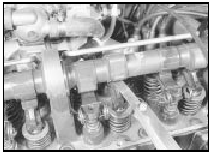
23.7a Using a feeler gauge to check a valve clearance
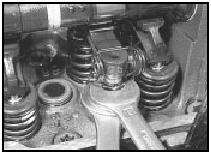
23.7b Adjusting a valve clearance
Allowance must be made for tightening the locknut, as this tends to decrease the valve clearance. Recheck the adjustment after tightening the locknut.
8 Repeat the procedure given in paragraphs 6 and 7 for the remaining valves. With the carburettor/inlet manifold fitted, some difficulty may be experienced when adjusting the exhaust valve clearances, and a suitable open-ended spanner bent to 90º will be found helpful.
9 Check the condition of the camshaft cover gasket, and renew if necessary. Fit the gasket to the camshaft cover ensuring that the locating tabs and dovetails are correctly located (see illustration),
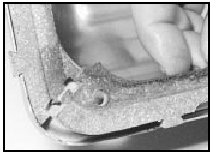
23.9a Camshaft cover gasket dovetails
then refit the
camshaft cover and tighten the securing bolts
in the order shown (see illustration),
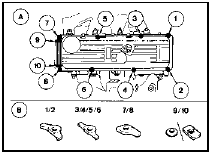
23.9b Camshaft cover bolts (A) and spacer plates (B)
Tighten bolts in following stages:
Stage 1 Bolts 1 to 6
Stage 2 Bolts 7 and 8
Stage 3 Bolts 9 and 10
Stage 4 Bolts 7 and 8 (again)
ensuring
that the spacer plates are in position under
the bolt heads, where applicable.
10 On fuel injection models, refit the inlet manifold bracing strut.
11 Where applicable refit the spark plugs.
Reconnect the HT leads and locate them in the clips on the camshaft cover.
12 Where applicable, refit any wires and hoses to the clips on the camshaft cover and on carburettor models, refit the air cleaner.
DOHC and CVH engines
13 These engines are fitted with hydraulic
cam followers therefore no adjustment is
necessary.
Handbrake check (Every 12 000 miles (20 000 km) or 12 months)
Chock the front roadwheels and jack the rear wheels clear of the ground, supporting the vehicle with axlestands.
Check that with the handbrake released, the rear wheels are free to rotate and no brake “bind” is evident. The handbrake lever travel should be between two and four clicks of the ratchet. If brake “bind” or excessive lever travel is evident, check the handbrake cable routing and check the self-adjuster mechanism for wear or damage. Refer to Chapter 10 for full service information.
Radiator matrix and air conditioner condenser clean (Every 12 000 miles (20 000 km) or 12 months)
Gain access to the radiator matrix by removing the surrounding body panels, fan shrouds, etc. Clean dirt and debris from the matrix using an air jet or water and a soft brush. Be careful not to damage the fins or cut your fingers.
Remove the protecting grille and clean any leaves, insects etc. from the air conditioner condenser coil and fins. Be very careful not to damage the condenser fins: use a soft brush, or a compressed air jet, along (not across) the fins.
See also:
Throttle Position Sensor (TPS) - removal and refitting
Removal
Note: During this procedure, ensure that the
sensor wiper is not rotated beyond its normal
operating arc
1 Disconnect the battery negative lead.
2 Disconnect the wiring plug from the sens ...
Spark plugs and HT leads - removal, inspection and refitting
Note: The correct functioning of the spark plugs
is vital for the correct running and efficiency of
the engine. It is essential that the plugs fitted are
appropriate for the engine, and the suitabl ...
Rear suspension/final drive unit rear mounting (Saloon, Hatchback and Estate
models) - renewal
Note: From May 1986, revised rear
suspension/final drive unit rear mounting bolts
have been used in production. Whenever the
earlier type of bolts are removed, they should
be discarded and the lat ...
